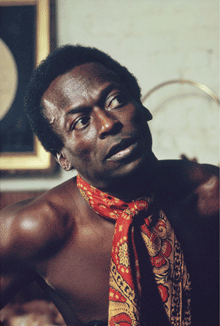The Cellar Door Sessions 1970 is the eighth posthumously released Miles Davis boxed set delivered from the Columbia vaults since the "Miles Davis Series" program began in 1996, and that’s not counting re-releases and special editions of single discs. The best of the boxes have been repackagings (with extras) of classic multi-album dates: the Gil Evans albums, the Coltrane sessions, the "second classic quintet" recordings (with Wayne Shorter, Herbie Hancock, Ron Carter, and Tony Williams). The results have been less satisfying with the expanded, multi-CD boxes of what were originally single-album projects: The Complete Bitches Brew Sessions, The Complete In a Silent Way Sessions, The Complete Jack Johnson Sessions. If these sets suffer by comparison, it’s because the albums that were drawn from them, the compositions that made them famous, were created in the editing room. They don’t exist in nature.
 This may sound odd in the post-hip-hop rock-and-roll era, where it’s taken for granted that "production" equals composition. But Miles and his bands, at least in this period and through the beginning of his six-year hiatus from performing and recording that began in 1974, recorded essentially as jazz bands always had: live, in real time. There were no overdubs. Miles brought his crew into the studio with little or no preparation, just a few sketched ideas, and directed them while producer Teo Macero oversaw the reel-to-reels. (One of the many headphone pleasures of Bitches Brew is hearing Miles’s hoarse whisper: "Let’s keep it like that, nice and tight.") From these day-long jams came hours of tape that Miles and Macero chopped and screwed into shape.
This may sound odd in the post-hip-hop rock-and-roll era, where it’s taken for granted that "production" equals composition. But Miles and his bands, at least in this period and through the beginning of his six-year hiatus from performing and recording that began in 1974, recorded essentially as jazz bands always had: live, in real time. There were no overdubs. Miles brought his crew into the studio with little or no preparation, just a few sketched ideas, and directed them while producer Teo Macero oversaw the reel-to-reels. (One of the many headphone pleasures of Bitches Brew is hearing Miles’s hoarse whisper: "Let’s keep it like that, nice and tight.") From these day-long jams came hours of tape that Miles and Macero chopped and screwed into shape.
So it’s not as if there were any "early take" of In a Silent Way. What you get are the bits and pieces that went into what we now know as In a Silent Way. Aside from keyboardist Joe Zawinul’s original sketch for the piece, everything was done with a razor blade and mixing — dropping out certain tracks, bringing in others.
"From the time the studio musicians start playing," Macero told Downbeat in 1974, "we take down every note of music, and all that music is intact in the vault at CBS. It’s not cut. It’s not edited. So there’s an archive of Miles Davis that won’t quit and it’s all in perfect, mint condition."
That archive still hasn’t quit. Novelist Frederick Barthelme has described his own practice of talking his fiction into a tape recorder as a good way to "generate text" — text that can then be transcribed and molded. Macero talks about editing as "shifting the compositions around so that the front becomes the back, the back becomes the middle, the middle something else. . . . I may have 15 reels of Miles and I cut those reels down; or I may have five and I cut it down to two. I don’t know. I keep listening to it over and over with the engineer, and finally Miles comes in and listens to it and he sort of smiles and he walks out."